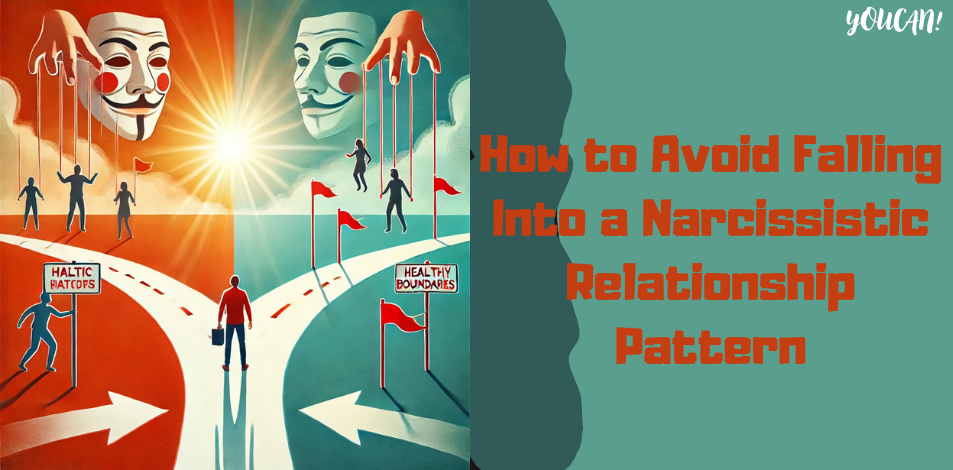
Falling into a narcissistic relationship pattern can be emotionally draining and harmful. These relationships are often characterized by manipulation, emotional abuse, and a constant need for validation from the narcissist. Understanding how to recognize these patterns early on is crucial in breaking free from the cycle and protecting your emotional well-being. Here’s how you can avoid falling into a narcissistic relationship pattern.
1. Understand the Signs of Narcissism
One of the most important steps in avoiding narcissistic relationships is being able to recognize the signs of narcissism early. Individuals with Narcissistic Personality Disorder (NPD) often exhibit traits such as:
Excessive Need for Admiration: Narcissists crave constant validation and admiration from others, often putting their own needs above everyone else’s.
Lack of Empathy: They struggle to understand or care about the feelings and needs of others, making emotional connection difficult.
Related : The Role of Genetics in Narcissistic Personality Disorder
Grandiosity: Narcissists often have an inflated sense of their own importance and capabilities, believing they are superior to others.
Manipulative Behavior: They tend to manipulate those around them to maintain control and fulfill their own needs, whether through emotional manipulation or outright deceit.
Recognizing these traits in potential partners early on can help you avoid getting caught in a narcissistic relationship.
2. Identify Your Own Vulnerabilities
Narcissists are often drawn to people who have specific vulnerabilities, such as low self-esteem, a desire to please, or a history of being in toxic relationships. These characteristics can make someone more susceptible to narcissistic manipulation. To avoid falling into this pattern, it’s important to understand your own vulnerabilities and work on strengthening your sense of self-worth and boundaries.
Build Self-Esteem: The higher your self-esteem, the less likely you are to seek validation from others or tolerate unhealthy behavior. Invest in your self-worth by acknowledging your strengths, accomplishments, and values.
Establish Clear Boundaries: Narcissists often push boundaries in subtle ways, so learning to assertively protect your emotional space is essential. Know what behaviors are unacceptable to you, and be prepared to walk away if those boundaries are crossed.
3. Watch for Love-Bombing
Love-bombing is a common tactic used by narcissists to draw people into their orbit. At the beginning of a relationship, they may shower you with attention, compliments, and gifts to create an intense emotional connection. This overwhelming affection can feel exhilarating, but it’s often a red flag for manipulative behavior.
Pace the Relationship: If someone is moving too fast—talking about commitment, love, or the future early on—it’s important to slow things down. Healthy relationships take time to develop, and moving too quickly can indicate manipulation or ulterior motives.
Look for Consistency: A genuine partner will be consistent in their words and actions over time, rather than alternating between extremes of affection and neglect.
4. Trust Your Gut Instinct
Many people in narcissistic relationships report that they had a gut feeling early on that something wasn’t right, but they ignored it. It’s easy to rationalize or overlook problematic behaviors, especially when they’re paired with charm and charisma. However, learning to trust your intuition is key to avoiding toxic relationships.
Listen to Red Flags: If something feels off, it probably is. Pay attention to signs of manipulative or controlling behavior, even if they seem small at first.
Related : What Is Narcissistic Personality Disorder (NPD)?
Don’t Dismiss Your Concerns: If you feel uncomfortable or disrespected, don’t minimize your feelings. Address issues directly and honestly, and be willing to walk away if your concerns are dismissed or ignored.
5. Avoid Codependency
Codependent individuals often find themselves in relationships with narcissists because they derive their sense of self-worth from taking care of others or being needed. Codependency can make it difficult to set boundaries or leave unhealthy relationships, as the person feels responsible for the narcissist’s happiness.
Work on Independence: Foster a sense of independence in your life by focusing on your own goals, passions, and needs outside of the relationship.
Recognize Enabling Behaviors: If you find yourself excusing or justifying a partner’s narcissistic behavior, it may be a sign of codependency. Instead of enabling these patterns, focus on holding the other person accountable for their actions.
6. Surround Yourself with a Support System
One of the reasons people remain trapped in narcissistic relationships is because they become isolated from friends and family who might recognize the unhealthy dynamics. Narcissists often discourage close relationships outside the partnership to maintain control over their victims.
Maintain Healthy Relationships: Keeping strong relationships with friends, family, and other support networks can provide perspective and help you recognize red flags that you might miss.
Seek Professional Help: If you’ve been in a pattern of narcissistic relationships, therapy can be an invaluable tool for understanding why this pattern occurs and how to break it. A therapist can help you build stronger boundaries, improve self-esteem, and navigate healthy relationships.
7. Focus on Emotional Health and Healing
Breaking free from a narcissistic relationship pattern isn’t easy, especially if you’ve been in more than one toxic relationship. It’s important to focus on emotional healing and recovery to avoid repeating the cycle.
Engage in Self-Care: Prioritize activities that help you relax, recharge, and feel grounded. This could be anything from physical exercise to journaling or meditation.
Practice Self-Compassion: Many people blame themselves for falling into narcissistic relationships, but it’s important to be gentle with yourself. Healing takes time, and acknowledging the progress you’ve made is essential to long-term recovery.
Conclusion
Avoiding a narcissistic relationship pattern requires self-awareness, strong boundaries, and the ability to recognize early warning signs of narcissism. By focusing on your own emotional health, trusting your instincts, and surrounding yourself with supportive people, you can break the cycle of toxic relationships and cultivate healthier, more fulfilling connections. Remember, it’s never too late to change your relationship patterns and prioritize your well-being.




